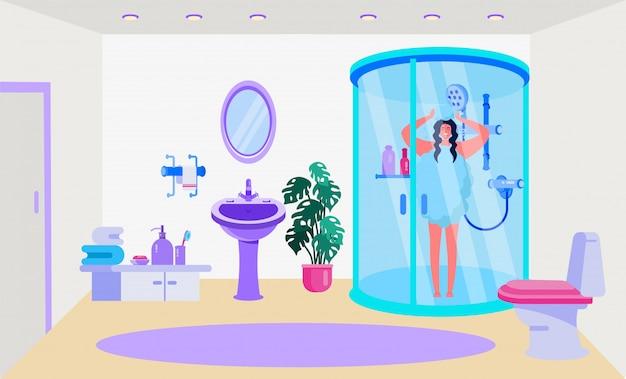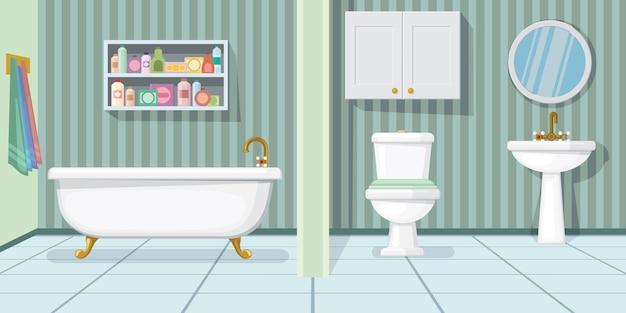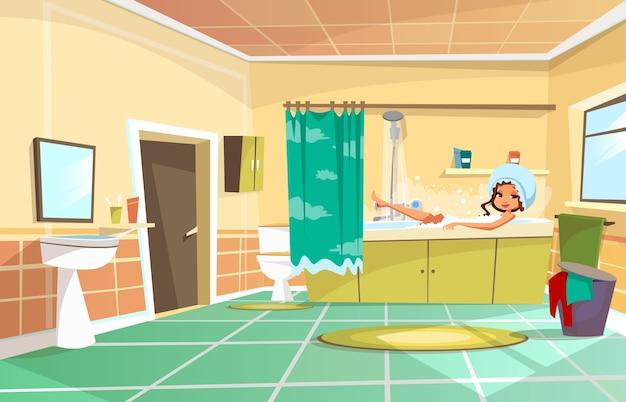Picture this — you step out of your upstairs bathroom, and you suddenly hear an unusual sound. You turn around, and all you see is water overflowing from the toilet, shower, or sink, flooding your once pristine bathroom floor. Don’t panic, though! Bathroom flooding happens more often than you might think.
There are several reasons why an upstairs bathroom can flood, and it can range from something as simple as a clogged drain to something more serious, like a leak. Whatever the cause, it’s important to take immediate action to prevent long-term damage to your home.
In this comprehensive guide, we’ll share with you what to do in case your upstairs bathroom floods. We’ll discuss common causes of bathroom flooding, how to deal with the aftermath, and steps to take to prevent it from happening again.
So, if you’ve experienced a flooded bathroom before, or you’re just looking for a solution to prevent it from happening, then keep reading. We’ve got you covered.
What to Do If Upstairs Bathroom Flooded
A flooded bathroom, especially the one upstairs, is not only an inconvenience but also a nightmare. It can cause extensive damage to your property, not to mention the potential risk of electrical hazards. In this subsection, we’ll explore some helpful tips on what to do if your upstairs bathroom is flooded.
Turn Off the Water Supply
The first thing you need to do is turn off the water supply to the bathroom. The valve is typically located near the sink or toilet and may be marked with a tag or color-coded. Shutting off the water supply will prevent further flooding and water damage.
Drain the Water
It’s important to remove as much water as possible as soon as possible to minimize damage. Depending on the severity of the flooding, you may need to use a wet/dry vacuum or a mop and bucket to drain the water. Be sure to wear protective gear such as gloves and boots while cleaning up the water.
Assess the Damage
Once you’ve removed the water, assess the damage to determine the extent of repairs needed. Check for any signs of mold growth or damage to the walls, ceiling, and floors. If you notice any significant damage, seek professional help to prevent further damage.
Call Your Insurance Company
If you have homeowner’s insurance, it’s important to contact them immediately and file a claim. They will send an adjuster to assess the damage, and they may cover the cost of repairs depending on your policy.
Hire a Professional
Depending on the severity of the damage, you may need to hire a water damage restoration professional. They have the expertise and equipment needed to remove any remaining water, dry out the area, and repair any damage. Be sure to choose a reputable and licensed company to ensure quality work.
In conclusion, a flooded upstairs bathroom can be a stressful and overwhelming experience. However, following the steps outlined above can help minimize damage and get your bathroom back to normal as soon as possible.
Dealing with the Flooded Bathroom Excuse
If you have ever had to deal with a flooded bathroom, you know it can be a nightmare. But what if you’re dealing with a flooded bathroom excuse? Here are some tips on how to handle it.
Don’t Fall for It
The first thing you need to do when confronted with the flooded bathroom excuse is to assess the situation. Is the bathroom actually flooded, or is it just an excuse? If you suspect that it’s just an excuse, don’t fall for it. Ask for proof, such as pictures or videos of the flooding.
Get to the Root of the Problem
If the bathroom is actually flooded, you need to get to the root of the problem. Is there a leaky pipe? Is the toilet overflowing? Once you know what’s causing the flooding, you can start to fix the problem.
Document Everything
If you’re dealing with a flooded bathroom excuse, it’s important to document everything. Take pictures or videos of the flooding, the damage, and any repairs that are made. This will help you later if you need to file an insurance claim or take legal action.
Communicate Clearly
Communication is key when dealing with a flooded bathroom excuse. Be clear and concise when talking to the person who is using the excuse. Let them know that you take the situation seriously and that you expect them to do the same.
Take Preventive Measures
Prevention is always better than cure. Once you have fixed the problem causing the flooding, take preventive measures to ensure that it doesn’t happen again. This could mean installing a flood sensor or hiring a professional plumber to check for any potential issues.
In conclusion, a flooded bathroom can be a real problem, but a flooded bathroom excuse can be even worse. By following these tips, you can handle the situation with confidence and ensure that you’re not being taken advantage of.
What To Do If Your Upstairs Bathroom Floods
A flooded bathroom can turn your home into a nightmare. It is a pervasive problem that most homeowners have dealt with at some point. The dangers posed by a flooded bathroom are legion, ranging from the mold and mildew that can result from the water damage to the potential slip and fall accidents.
Shut Off The Water
Before doing anything, immediately turn off the water source to your bathroom. The water valve typically is located under the sink or behind the toilet. If it’s not there, look for a shutoff valve near the bathroom. Turn the knob clockwise to close the valve and prevent more water from entering your bathroom.
Call A Professional
Water damage can be catastrophic, and even minor flooding can have long-term consequences. So, you might want to consider contacting a professional. A professional water damage restoration company has the expertise and equipment needed to detect and fix the problem quickly and efficiently. They can also sanitize and dry your house to prevent mold growth, which can cause significant health concerns.
Clear the Water
You should begin by removing the water from your bathroom as soon as possible. If the flooding is caused by a broken pipe, you can use a bucket to collect the water and empty it outside. If the flooding is caused by a clogged toilet or drain, use a plunger or plumbing snake to clear the blockage. Additionally, use mops, towels, and a wet-dry vacuum to remove any remaining water.
Dry the Space
Once you have cleared the water from your bathroom, it’s essential to dry the space completely. You must use fans or dehumidifiers to expedite the drying process. Use a dry mop or towels to clean the floors and walls. If any water damage is visible, you might need to remove the baseboards or drywall to prevent the growth of mold and mildew.
Prevent Future Floods
To avoid future incidences of flooded bathrooms, you must take proactive measures to prevent them. One of the best ways to prevent bathroom flooding is by performing regular maintenance. Keep your bathroom pipes and drains in good condition by fixing any leaks or clogs promptly. Additionally, consider taking the preventive measure of installing a floor drain that can catch any accidental overflow, preventing significant flooding.
In summary, if your upstairs bathroom floods, shut off the water source, call a professional, remove the water, dry the space, and take preventive measures to avoid future floods. It’s a daunting task, but if handled promptly and efficiently, you can mitigate the damage caused by water.
Bathroom Floor Flooded After Shower
After a relaxing shower, stepping onto a flooded bathroom floor can be a shock. A bathroom floor flood after a shower can be caused by several factors that can ruin your mood and even damage your bathroom’s floor. Here are the immediate steps you can take to address the issue:
Turn Off the Water Supply
If you notice that the bathroom floor is flooded after a shower, the first step is to turn off the water supply to prevent further flooding. If you don’t know where the shut-off valve is located, you can check the bathroom wall or under the sink to locate the valve.
Check for Any Leaks
After turning off the water supply, check the pipes, fittings, and showerhead for any leaks. If you detect any leaks, you should immediately make repairs or call a plumber to fix the problem.
Dry the Bathroom Floor
After checking and fixing any leaks, start drying the bathroom floor. Use a mop, towels, or a wet/dry vacuum to remove as much water as possible.
Address the Cause of the Flood
To prevent future floods, address the cause of the problem. For instance, if the shower drain is clogged, you can use a plunger or specialized tool to clear the blockage. Alternatively, you can hire a professional plumber to clean and unclog the drain for you.
Prevent Mold Growth
After drying the bathroom floor, it is essential to prevent mold growth. Mold can start growing within 24-48 hours, depending on the humidity level. You can use a dehumidifier to reduce moisture levels in the bathroom, or turn on a bathroom fan to dry the area.
In conclusion, if you notice a bathroom floor flood after taking a shower, the first step is to turn off the water supply, check for leaks, dry the bathroom floor, address the cause of the flood, and prevent mold growth. If the flood is too much to handle on your own, it’s best to call a professional plumber to help you out.
How to Deal With a Flooded Bathroom
Accidents happen, and when they do, it’s essential to know what to do when an upstairs bathroom floods. Here are some steps you can take to deal with a flooded bathroom:
Step 1: Turn Off the Water Supply
The first thing you need to do is turn off the water supply. The shut-off valve is usually located near the toilet or under the sink. Shutting off the water supply will prevent any more water from flowing into the bathroom, which can cause more damage.
Step 2: Identify the Cause of the Flooding
Once you’ve turned off the water supply, you need to identify the cause of the flooding. Are there any leaks or cracks in the pipes, or did the toilet overflow? Knowing the cause of the flooding will help you determine the severity of the situation and the extent of the damage.
Step 3: Clean Up the Water
After identifying the cause of the flooding, it’s time to clean up the water. Use a mop or towels to soak up as much water as possible. Be sure to wear gloves and boots to protect yourself, as the water may be contaminated.
Step 4: Dry the Area
After cleaning up the water, use fans and dehumidifiers to dry the area. Drying the area will prevent mold and mildew from growing. If there is any drywall or insulation that has been damaged, you may need to remove and replace it.
Step 5: Assess the Damage
Finally, assess the damage. If the damage is minor, such as a small leak, you may be able to fix it yourself. However, if the damage is severe, such as a burst pipe, you may need to hire a professional plumber to fix it.
In conclusion, dealing with a flooded bathroom can be stressful, but by following these steps, you can minimize the damage and get your bathroom back to its normal state. Remember to always turn off the water supply, identify the cause of the flooding, clean up the water, dry the area, and assess the damage.
How to Treat a Flooded Bathroom
When your upstairs bathroom has flooded, it can be overwhelming and stressful. The water damage caused by the flood can lead to costly repairs and even pose health risks. However, with the right knowledge and tools, you can effectively handle a flooded bathroom. Here is what you need to do:
Turn Off the Water and Power Supply
The first step to take when dealing with a flooded bathroom is to turn off the water supply to prevent further damage. You can either turn off the main water valve or the valve that leads to the bathroom. Next, turn off the power supply to the bathroom to avoid any electrical hazards that may arise from the flooding.
Remove the Standing Water
Use a wet/dry vacuum or a bucket to remove the standing water from the bathroom. Take care not to use any electrical appliances when removing the water to avoid electrocution.
Dry Out the Affected Area
Use towels, a mop, or a dehumidifier to dry out any remaining moisture in the bathroom. If the flooded area is large, you may need to use a high-powered fan to circulate air in the room and hasten the drying process.
Disinfect the Bathroom
Once you have removed the water and dried out the area, it is important to disinfect the bathroom. Use a bleach solution to clean and disinfect all surfaces, including the floor, walls, and any affected fixtures. This will help prevent mold and bacteria growth in the bathroom.
Call a Professional
If the flood damage is extensive or if you are unsure how to handle the situation, it is best to call a professional water damage restoration company. They have the expertise, tools, and equipment to handle the situation safely and effectively.
In conclusion, a flooded bathroom can be a stressful experience, but with these steps, you can handle the situation effectively and mitigate the damage caused by the flood. Remember to turn off the water and power supply, remove the standing water, dry out the affected area, disinfect the bathroom, and call a professional if needed.
What to Do if You Flood Upstairs Bathroom
Flooded upstairs bathrooms are a common problem experienced by homeowners. It can be caused by various reasons such as clogged toilets, burst pipes, or overflowing bathtubs. Here are some tips on what to do if your upstairs bathroom has flooded.
Turn off the Water Supply
The first thing you should do is turn off the water supply to your house. This will prevent further water from flowing into the flooded bathroom. Locate the main shutoff valve for the water supply to your house, which is generally found near the water meter or where the municipal water line enters your home. Turn off the valve clockwise until it stops.
Assess the Damage
Assessing the damage caused by the flooded bathroom is important. Depending on the severity of the flood, you may need to call a professional water damage restoration company. Check if water has also gone into other rooms adjacent to the bathroom. Look for water stains on walls or ceilings, and check for any electrical damage.
Remove the Water
After assessing the damage, you should start removing the water from the bathroom. You can use a wet vacuum or a mop and bucket to remove standing water. Make sure to wear rubber gloves and boots to avoid any physical contact with the water as it may be contaminated.
Dry the Area
Once you have removed the standing water, it is essential to dry the area thoroughly. Use fans, dehumidifiers, or open windows to dry out the air and prevent mold growth. Remove any wet carpets, towels, or other linens that may have come into contact with the water.
Call a Professional
If the damage is too severe, it is best to call a water damage restoration professional who can help you mitigate damages and perform the necessary repairs. They have the right equipment and knowledge to deal with any water damage situation effectively.
In conclusion, flooding in an upstairs bathroom can be a distressing experience. However, following these simple steps can help you minimize damage and prevent further complications. Remember to act quickly, assess the damage, remove the water, and dry the area. If the situation gets out of hand, don’t hesitate to seek professional help.
Upstairs Bathroom Flooded Leaking Through Ceiling
Have you ever experienced an upstairs bathroom flooded and leaking through the ceiling? If you have, then you know it’s not only a major inconvenience but also a serious problem that needs to be addressed immediately. Here are some steps to take if you find yourself in this situation:
Shut off the Water Supply
The first thing you should do is shut off the water supply to the bathroom. This will prevent any further water from flowing into the space and causing more damage. Locate the shut-off valve and turn it in a clockwise direction until it’s completely closed.
Assess the Damage
Before you start cleaning up the mess, assess the damage so you can determine how best to proceed. Look at the ceiling and walls to see how far the water has spread. If you notice any bulges or cracks, this is a sign that the water has caused damage to the drywall. If the damage is extensive, you may need to call a professional.
Remove the Water
Use a wet/dry vacuum to remove as much water as possible from the floor and any furniture or fixtures in the area. If you don’t have a wet/dry vacuum, you can use towels or a mop to soak up the excess water. Be sure to wring out the towels or mop bucket frequently to avoid spreading water to other areas.
Dry the Area
Once you have removed as much water as possible, you need to dry the area thoroughly. You can use fans, dehumidifiers, or open windows to help dry out the space. Be sure to keep the area well ventilated to prevent mold growth.
Repair the Ceiling
Finally, you need to repair the ceiling. If you notice any cracks or bulges, you’ll need to replace the drywall. Once the new drywall is in place, you can paint it to match the rest of the ceiling.
In conclusion, an upstairs bathroom flood that leaks through the ceiling can be a challenging issue to handle, but by following these steps, you can minimize the damage and get your home back to normal. If the damage is too extensive or you are unsure of how to repair it, don’t hesitate to call a professional for help.



